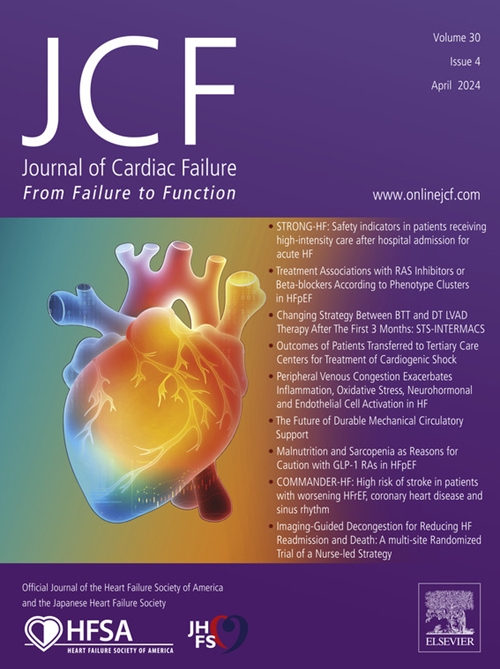将患者报告的生活质量数据纳入心力衰竭风险评估。
IF 6.7
2区 医学
Q1 CARDIAC & CARDIOVASCULAR SYSTEMS
引用次数: 0
摘要
导言:要对门诊心力衰竭(HF)患者进行最佳管理,就必须不断更新对其不良临床结果风险的估计,以指导治疗。患者报告结果(PROs)在临床治疗中的应用越来越广泛。本研究的目的是确定纳入PROs是否能改善非卧床心衰患者的心衰住院和死亡风险预测:我们纳入了 2015 年至 2019 年期间在一家心房颤动诊所就诊的连续射血分数降低型心房颤动(HFrEF)和射血分数保留型心房颤动(HFpEF)患者,这些患者在常规护理中填写了 PROs。采用带有最小绝对收缩和选择算子(LASSO)正则化的 Cox 回归和梯度提升机(GBM)分析来估计高频住院、心脏移植、左心室辅助装置植入或死亡等综合结果的风险。预测模型的性能通过时间相关一致性指数(Cτ)进行评估:1165名HFrEF患者(平均年龄59.1±16.1岁,68%为男性)的中位随访时间为487天,456名HFpEF患者(平均年龄64.2±16.0岁,55%为男性)的中位随访时间为494天。包括PROs在内的梯度提升回归具有最佳的预测效果--HFrEF患者的Cτ为0.73,HFpEF患者的Cτ为0.74,并且通过按风险五分位数进行事件发生时间分析,显示出非常好的风险分层效果。堪萨斯城心肌病问卷总体总分(KCCQ-12 OSS)、视觉模拟量表(VAS)和患者报告结果测量信息系统(PROMIS)的社会角色满意度和身体功能维度在模型中具有较高的变量重要性:结论:PROs 可改善 HFrEF 和 HFpEF 的风险预测,不受传统临床因素的影响。在常规临床护理中,对PROs进行常规评估并利用电子健康记录中的综合数据,有助于更准确地评估高血压患者的风险并支持加强治疗。本文章由计算机程序翻译,如有差异,请以英文原文为准。
Integration of Patient Reported Quality-of-life Data into Risk Assessment in Heart Failure
Background
Optimal management of outpatients with heart failure (HF) requires serially updating the estimates of their risk for adverse clinical outcomes to guide treatment. Patient-reported outcomes (PROs) are becoming increasingly used in clinical care. The purpose of this study was to determine whether the inclusion of PROs can improve the risk prediction for HF hospitalization and death in ambulatory patients with HF.
Methods and Results
We included consecutive patients with HF with reduced ejection fraction (HFrEF) and HF with preserved EF (HFpEF) seen in a HF clinic between 2015 and 2019 who completed PROs as part of routine care. Cox regression with a least absolute shrinkage and selection operator regularization and gradient boosting machine analyses were used to estimate risk for a combined outcome of HF hospitalization, heart transplant, left ventricular assist device implantation, or death. The performance of the prediction models was evaluated with the time-dependent concordance index . Among 1165 patients with HFrEF (mean age 59.1 ± 16.1, 68% male), the median follow-up was 487 days. Among 456 patients with HFpEF (mean age 64.2 ± 16.0 years, 55% male) the median follow-up was 494 days. Gradient boosting regression that included PROs had the best prediction performance – 0.73 for patients with HFrEF and 0.74 in patients with HFpEF, and showed very good stratification of risk by time to event analysis by quintile of risk. The Kansas City Cardiomyopathy Questionnaire overall summary score, visual analogue scale and Patient Reported Outcomes Measurement Information System dimensions of satisfaction with social roles and physical function had high variable importance measure in the models.
Conclusions
PROs improve risk prediction in both HFrEF and HFpEF, independent of traditional clinical factors. Routine assessment of PROs and leveraging the comprehensive data in the electronic health record in routine clinical care could help more accurately assess risk and support the intensification of treatment in patients with HF.
求助全文
通过发布文献求助,成功后即可免费获取论文全文。
去求助
来源期刊

Journal of Cardiac Failure
医学-心血管系统
CiteScore
7.80
自引率
8.30%
发文量
653
审稿时长
21 days
期刊介绍:
Journal of Cardiac Failure publishes original, peer-reviewed communications of scientific excellence and review articles on clinical research, basic human studies, animal studies, and bench research with potential clinical applications to heart failure - pathogenesis, etiology, epidemiology, pathophysiological mechanisms, assessment, prevention, and treatment.
 求助内容:
求助内容: 应助结果提醒方式:
应助结果提醒方式:


